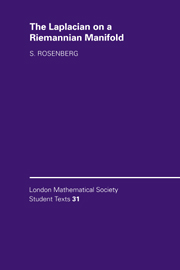1 - The Laplacian on a Riemannian Manifold
Published online by Cambridge University Press: 24 December 2009
Summary
In this chapter we will generalize the Laplacian on Euclidean space to an operator on differential forms on a Riemannian manifold. By a Riemannian manifold, we roughly mean a manifold equipped with a method for measuring lengths of tangent vectors, and hence of curves. Throughout this text, we will concentrate on studying the heat flow associated to these Laplacians. The main result of this chapter, the Hodge theorem, states that the long time behavior of the heat flow is controlled by the topology of the manifold.
In §1.1, the basic examples of heat flow on the one dimensional manifolds S1 and R are studied. The heat flow on the circle already contains the basic features of heat flow on a compact manifold, although the circle is too simple topologically and geometrically to really reveal the information contained in the heat flow. In contrast, heat flow on R is more difficult to study, which indicates why we will restrict attention to compact manifolds. In §1.2, we introduce the notion of a Riemannian metric on a manifold, define the spaces of L2 functions and forms on a manifold with a Riemannian metric, and introduce the Laplacian associated to the metric. The Hodge theorem is proved in §1.3 by heat equation methods. The kernel of the Laplacian on forms is isomorphic to the de Rham cohomology groups, and hence is a topological invariant. The de Rham cohomology groups are discussed in §1.4, and the isomorphism between the kernel of the Laplacian and de Rham cohomology is shown in §1.5.
- Type
- Chapter
- Information
- The Laplacian on a Riemannian ManifoldAn Introduction to Analysis on Manifolds, pp. 1 - 51Publisher: Cambridge University PressPrint publication year: 1997
- 2
- Cited by



